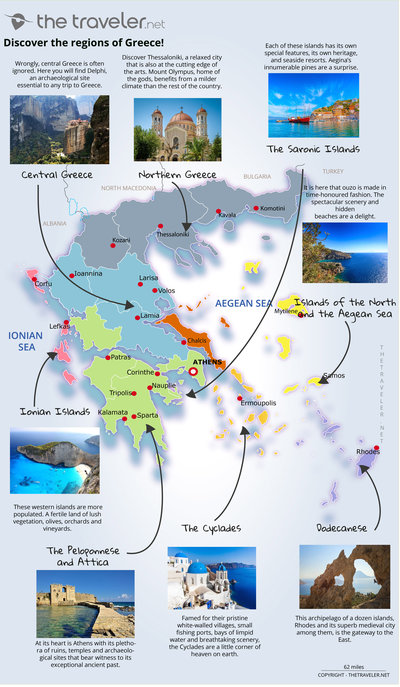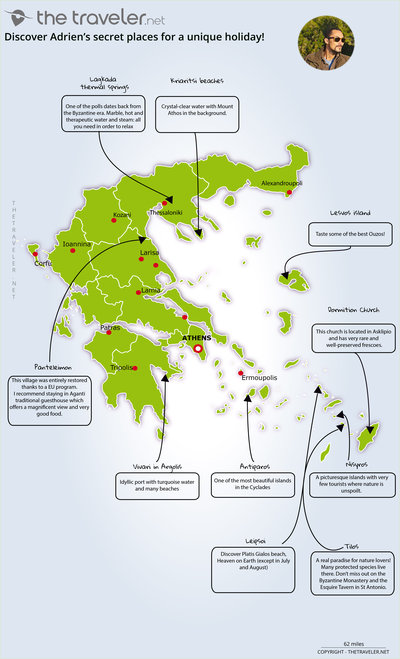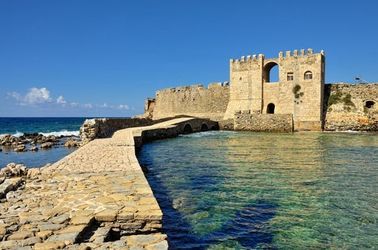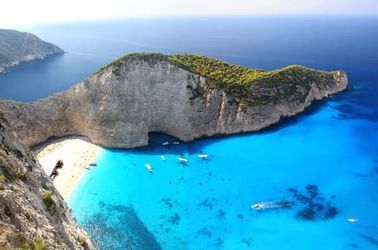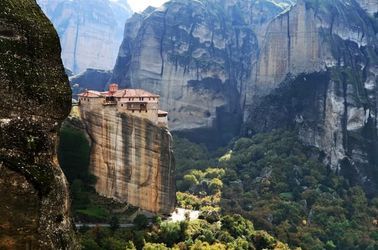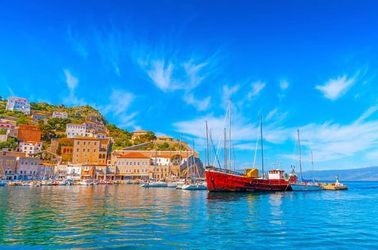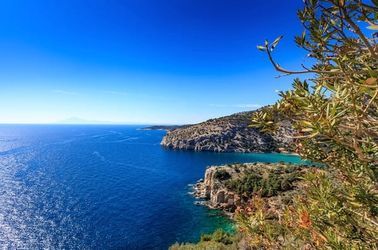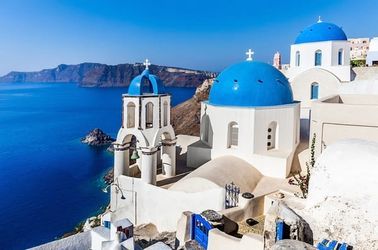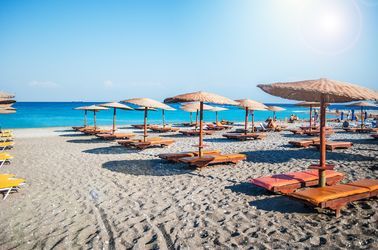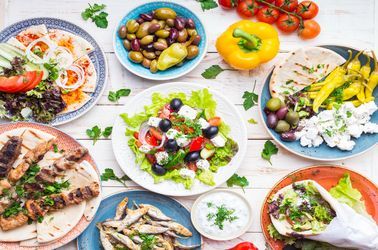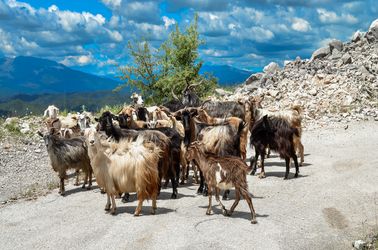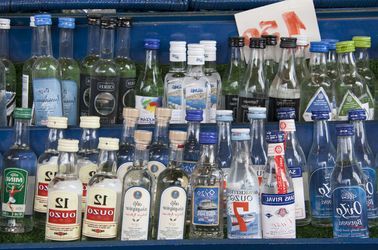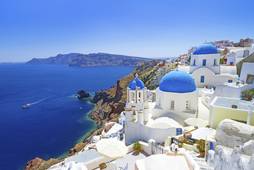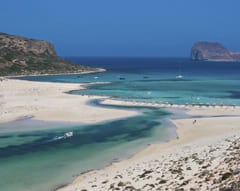Plan an amazing trip to Greece
The Gods have left their indelible mark on Greece. Traces of ancient history continue to fascinate enthusiasts of archaeology in this southern European land. Athens, Delphi and Thessaloniki are just some of the unmissable places to retrace the history and mythology of Greece. If the tradition of hospitality appears to be deserting the packed cities, the warm welcome you will find in the small villages will lift your heart. On the islands, you will find a gentler way of life. The medieval city of Rhodes, the immaculate white houses in the Cyclades (Aegean Islands) and the Minotaur’s lair in Crete have an appeal that promises a complete change. A holiday in Greece will do you a power of good.

Adrien's tips, Local guide in Greece
Best time to go to Greece
Greece rejoices in a Mediterranean climate. Winters are particularly mild and agreeable with an average temperature of around 10°C. On the other hand, summer temperatures are very high, particularly inland. Some areas are bathed in heat which borders on the unbearable and temperatures regularly exceed 30°C in July and August. Between July and OCTOBER, the Maltemi blows across the Aegean Islands, making swimming dangerous. Summer is marked by an almost total absence of rain throughout the country, and the period between December and January records the highest rainfall. Otherwise, spring and autumn are the best times to discover ancient treasure and cultural traditions on your trip to Greece.
What to see and what to do in Greece
Adrien answers your most frequently asked questions
Arrive in Athens, Delphi (with the option of visiting Galaxidi and Nafpaktos, two superb 19th-century naval towns). Cross the Rio Antirio bridge. Olympus, (with the option of visiting the temple of Apollo Epicurius in Vasses). Mystras, home of the last Byzantine emperors. Monemvasia, equivalent to the St. Michael’s mount, but in the Aegean. Nafplio, the most beautiful town in Greece, and formerly it's capital. Maybe a week isn’t enough, but this itinerary will allow you to take in the best of everything, and, at any to point, to extend your stay for a day depending on the driver’s fortitude.
The most beautiful beaches are the best known and are therefore easy to find. Halkidiki, the Ionian Islands and the mainland coastline opposite them, as well as the Cyclades and The Dodecanese are favoured with beautiful beaches where anyone can find what they are after. In Greece, seek and you will find! Most importantly, discover the wind’s direction and figure out the sun’s aspect. The most sheltered sandy beaches all face south or south-east: not only in relation to the island but also to the entrance to the bay. Bays whose entrances face north or north-west are exposed to the famous Maltemi wind (blustery and great for water sports) and will inevitably be pebbly, the waterless calm and the sea floor stony.
Natural sponges, pistachios from Aegina, leather sandals (an iconic local tradition), as well as tourist souvenirs can be found in “When in Greece” a collective of designers who are redefining the concept of Greek souvenirs. I also recommend the boutiques in the archaeological museums where you can find good value. Items are verified by the archaeological authorities. Reproductions of artefacts and jewels are officially endorsed. and local artisans publicly bid for tenders to produce the reproductions, so their reputations are reliable. And if you want to focus your mind or give up smoking, you can pick up the famous ‘komboloï’ - the worry beads esteemed by Greek men.
As well as Lesbos, Rhodes and Corfu, there are lesser known islands which, for that reason, are more picturesque and retain an authentic atmosphere and character that is unique to each.
- Samothrace
- Alonissos
- Skopelos
- Icaria
- Patmos
- Karpathos
- Naxos
- Paros
- Astypalaia
- Paxi
Greek food is the product of a wonderful mixture of traditions from the east and west. The country has a long list of specialities from starters to desserts. Among the best known is feta cheese. Often eaten in salads it can also be grilled. As elsewhere in the Mediterranean basin, seafood has an important place in Greek cuisine. Squid, octopus, prawns and fish are prepared in a variety of ways: fried, grilled, on skewers, etc. Octopus is often served as an amuse bouche with ouzo, the anise flavoured spirit. Ouzo, soumada (an almond milk drink), mastic gum from Chios and various liqueurs can be found everywhere, but take care to check whether they are genuine. Greek honey, olive oil and handmade products are cheaper as labour costs are lower. It is worthwhile investing in traditional jewellery as the prices of silver and gold are lower in Greece.
During Easter, firecrackers are set off to celebrate the resurrection. Beware, they can be quite powerful depending on where you are. Traditional soup of offal signifies the end of fasting. The Good Friday parade is the most impressive tradition and takes place everywhere in Greece. Every parish decorates a bier of the tomb of Christ with flowers. It is then carried through the streets followed by the faithful, the choir, monstrances, the cross, and a procession representing the gospels. Generally taking place in the evening, it’s best to ask a local the precise time of the event, which really shouldn’t be missed. It’s a celebration whose origins date back to ancient times and which the Romans adopted under the name of ‘Bacchanal’. Being hardened revellers, the Greeks never miss the opportunity to celebrate Good Friday and some towns are famous for their parades and the huge crowds they attract. A good atmosphere reigns as drunkenness is frowned upon and seen as a weakness. Some of the celebrations have retained their Dionysian heritage more than others and are particularly well thought of: Unbridled celebrations in Tyrnavos feature giant phalluses to ward off evil spirits. In Kastoria, where the dates differ, musicians play for three days as everyone in the street rejoices around them. In Naoussa the ‘Ragoutsaria'; carnival takes place to the sound of brass instruments simulating the sabre duels of the Ottoman empire. Icaria is known for the ‘Panigiri’ a traditional celebration held in August with folk music and (Greece has 180 dances). Every region has its local customs and saint’s day which should not be missed if you happen to be there. It’s an incomparable opportunity to participate in local life.
In the large towns and cities, shopping centres and brands dominate. The Kolonaki district in Athens is the place for designer boutiques, where you can discover beautiful jewellery and embroidery. The lively market in Monastiraki is popular and may reveal a few surprises which are worth a second glance. Leather sandals, pottery and ceramic are excellent souvenirs to take home. Food lovers might prefer olive oil, ouzo or retsina.
The seaside resorts and touristic sites which are so heavily visited in summer.
The archaeology and traces of antiquity.
The ever present sunshine.
The charm of the islands.
The ravines which delight walkers and hikers.
Useful information
Crete travel guide

